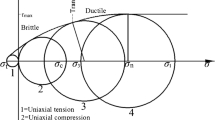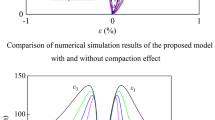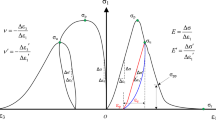Abstract
The damage and even failure of hard brittle rocks has been the most important challenge facing the safety of construction of deep engineering works, so the key to solving this problem is the recognition of the strength characteristics and description of the mechanical behavior of hard brittle rocks. Therefore, in view of this problem, in this study, we first analyzed the strength and mechanical response characteristics revealed in tests of, and site excavation in, hard brittle rocks. Second, by analyzing rock-strength envelopes on meridional and deviatoric planes, the generalized polyaxial strain energy (GPSE) strength criterion was applied. This allows description of the effects of the minimum principal stress, intermediate principal stress, hydrostatic pressure, and Lode’s angle of stress on the strength of hard rocks. By establishing evolutionary relationships of strength parameters and dilation parameters with plastic volumetric strain in rock failure, we established an elasto-plastic mechanical constitutive model for hard brittle rocks based on the GPSE criterion. In addition, through use of the failure approach index theory and the dilatancy safety factor, an evaluation index for degree of damage considering dilatant effects of rocks was proposed. Finally, the constitutive model established in this study and the proposed evaluation index were integrated into the numerical simulation method to simulate triaxial tests on rocks and numerical simulation of deformation and fracture of the rocks surrounding the deep-buried auxiliary tunnels in China’s Jinping II Hydropower Station. In this way, the reasonableness of the model and the index was verified. The strength theory and the constitutive model established in this research are applicable to the analysis of high-stress deformation and fracture of hard brittle rock masses, which supports the theoretical work related to deep engineering operations.


















Similar content being viewed by others
References
Kaiser PK, Kim BH. Characterization of strength of intact brittle rock considering confinement-dependent failure processes. Rock Mech Rock Eng. 2015;48:107–19.
Handin J, Heard HC, Magouirk JN. Effects of the intermediate principal stress on the failure of limestone, dolomite, and glass at different temperatures and strain rates. J Geophys Res. 1967;72(2):611–40.
Mogi K. Fracture and flow of rocks under high triaxial compression. J Geophys Res. 1971;76(5):1255–69.
Takahashi M, Koide H. Effect of the intermediate principal stress on strength and deformation behavior of sedimentary rocks at depth shallower than 2000 m. In: Maury V, Fourmaintraux D, editors. Rock at great depth, vol. 1. Rotterdam: Balkema; 1989. p. 19–26.
Chang C, Haimson B. True triaxial strength and deformability of the German Continental Deep Drilling Program (KTB) deep hole amphibolite. J Geophys Res. 2000;105(B8):18999–9013.
Haimson BC, Chang C. A new true triaxial cell for testing mechanical properties of rock, and its use to determine rock strength and deformability of Westerly granite. Int J Rock Mech Min Sci. 2000;37(1–2):285–96.
Mogi K. Effect of the intermediate principal stress on rock failure. J Geophys Res. 1967;72(20):5117–31.
Wiebols GA, Cook NGW. An energy criterion for the strength of rock in polyaxial compression. Int J Rock Mech Min Sci Geomech Abstr. 1968;5(6):529–49.
Lade P, Duncan J. Elasto-plastic stress–strain theory for cohesionless soil. ASCE J Geotech Eng Div. 1975;101(1):1037–53.
Zhou S. A program to model the initial shape and extent of borehole breakout. Comput Geosci. 1994;20(7/8):1143–60.
Aubertin M, Li L, Simon R, Khalfi S. Formulation and application of a short-term strength criterion for isotropic rocks. Can Geotech J. 1999;36(5):947–60.
Ewy RT. Wellbore-stability predictions by use of a modified lade criterion. SPE Drill Complet. 1999;14(02):85–91.
Yu M. Advances in strength theories for materials under complex stress state in the 20th Century. App Mech Rev. 2002;55(3):169–218.
Hudson JA, Harrison JP. Engineering rock mechanics—an introduction to the principles. Oxford: Pergamon Press; 1997.
Pelli F, Kaiser PK, Morgenstern NR. An interpretation of ground movements recorded during construction of the Donkin–Morien tunnel. Can Geotech J. 1991;28(28):239–54.
Martin CD. Seventeenth Canadian Geotechnical Colloquium: the effect of cohesion loss and stress path on brittle rock strength. Can Geotech J. 1997;34(5):698–725.
Hajiabdolmajid VR. Mobilization of strength in brittle failure of rock. Ph.D. thesis, Queen’s University, Canada; 2001.
Hajiabdolmajid VR, Kaiser PK, Martin CD. Modelling brittle failure of rock. Int J Rock Mech Min Sci. 2002;39(6):731–41.
Bažant ZP, Bhat PD. Endochronic theory of inelasticity and failure of concrete. J Eng Mech. 1976;102(4):701–22.
Desai CS, Toth J. Disturbed state constitutive modeling based on stress–strain and nondestructive behavior. Int J Solids Struct. 1996;33(11):1619–50.
Desai CS, Gens A. Mechanics of materials and interfaces: the disturbed state concept. J Electron Packag. 2001;123(4):406.
Han DJ, Chen WF. Strain space plasticity formulation for hardening–softening materials with elastoplastic coupling. Int J Solids Struct. 1986;22(8):935–50.
Liu D, He M, Cai M. A damage model for modelling the complete stress–strain relations of brittle rocks under uniaxial compression. Int J Damage Mech. 2017;27:1000–19.
Hillerborg A, Modéer M, Petersson PE. Analysis of crack formation and crack growth in concrete by means of fracture mechanics and finite elements. Cem Concr Res. 1976;6(6):773–81.
Kawamoto T, Ichikawa Y, Kyoya T. Deformation and fracturing behaviour of discontinuous rock mass and damage mechanics theory. Int J Numer Anal Met. 1988;12(1):1–30.
Shao JF, Rudnicki JW. A microcrack based continuous damage model for brittle geomaterials. Mech Mater. 2000;32(10):607–19.
Krajcinovic D. Damage mechanics. 2nd ed. Amsterdam: Elsevier Science; 2003.
Zhang CQ, Zhou H, Feng XT. An index for estimating the stability of brittle surrounding rock mass: FAI and its engineering application. Rock Mech Rock Eng. 2011;44(4):401–14.
Colmenares LB, Zoback MD. A statistical evaluation of intact rock failure criteria constrained by polyaxial test data for five different rocks. Int J Rock Mech Min Sci. 2002;39(6):695–729.
Descamps F, Tshibangu JP. Modelling the limiting envelopes of rocks in the octahedral plane. Oil Gas Sci Technol. 2007;62(5):683–94.
Tshibangu JP. The effect of a polyaxial confining state on the behaviour of two limestones. In: Lee Y, Cheng, editors. Environmental and safety concerns in underground construction. Rotterdam: Balkema; 1997. p. 465–70.
Zhang JC, Xu WY, Wang HL, Wang RB, Meng QX, Du SW. A coupled elastoplastic damage model for brittle rocks and its application in modelling underground excavation. Int J Rock Mech Min Sci. 2016;84:130–41.
Castro J, Cicero S, Sagaseta C. A criterion for brittle failure of rocks using the theory of critical distances. Rock Mech Rock Eng. 2016;49:63–77.
Huang S, Feng X, Zhang C. A new generalized polyaxial strain energy strength criterion of brittle rock and polyaxial test validation. Chin J Rock Mech Eng. 2008;27(1):124–34 (in Chinese).
Alejano LR, Alonso E. Considerations of the dilatancy angle in rocks and rock masses. Int J Rock Mech Min Sci. 2005;42(4):481–507.
Cerfontaine B, Charlier R, Collin F, Taiebat M. Validation of a new elastoplastic constitutive model dedicated to the cyclic behaviour of brittle rock materials. Rock Mech Rock Eng. 2017;50(10):2677–94.
Martin CD. Strength of massive Lac du Bonnet granite around underground openings. Ph.D. thesis, University of Manitoba, Winnipeg; 1993.
Acknowledgements
The work was supported by the National Key Research and Development Project of China (Grant No. 2016YFC0401804), the Key projects of the Yalong River Joint Fund of the National Natural Science Foundation of China (Grant No. U1865203), and the National Natural Science Foundation of China (Grant Nos. 51539002 and 51779018). It was also supported by the Basic Research Fund for Central Research Institutes of Public Causes (CKSF2017054/YT).
Author information
Authors and Affiliations
Corresponding author
Ethics declarations
Conflict of Interest
The authors declare that they have no conflict of interest.
Rights and permissions
About this article
Cite this article
Huang, S., Zhang, C. & Ding, X. Hardening–Softening Constitutive Model of Hard Brittle Rocks Considering Dilatant Effects and Safety Evaluation Index. Acta Mech. Solida Sin. 33, 121–140 (2020). https://doi.org/10.1007/s10338-019-00108-4
Received:
Revised:
Accepted:
Published:
Issue Date:
DOI: https://doi.org/10.1007/s10338-019-00108-4




